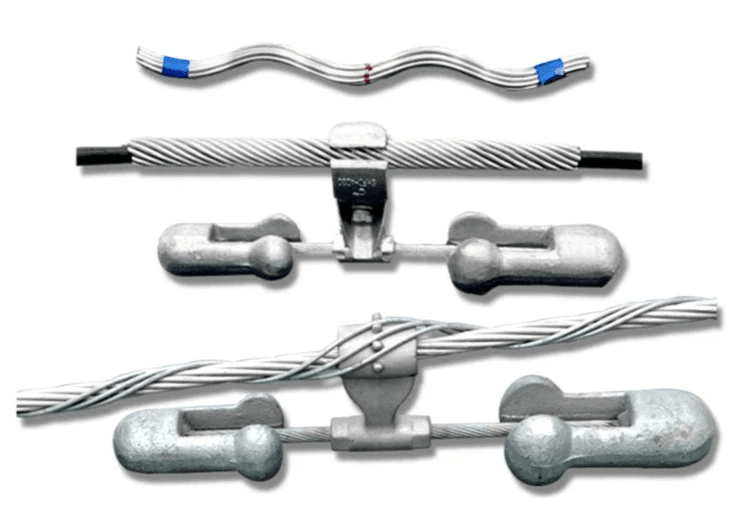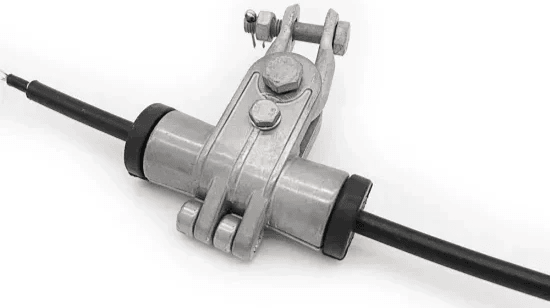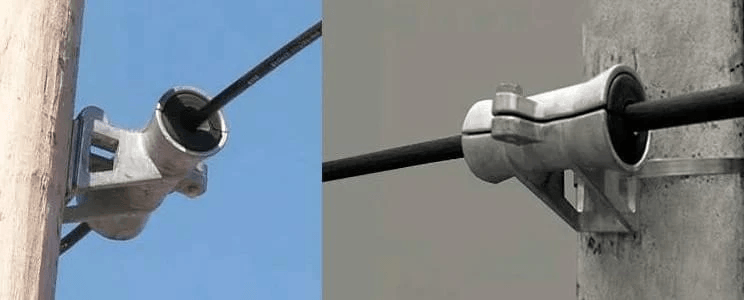Introduction

In the rapidly evolving world of telecommunications, the significance of ADSS fittings cannot be overstated. These specialized components are essential for ensuring the reliability and longevity of fiber optic networks, particularly in challenging environments where traditional methods may fall short. By understanding the importance of ADSS fittings, we can appreciate how they enhance connectivity and support modern communication infrastructures.
Understanding the Importance of ADSS Fittings
ADSS (All-Dielectric Self-Supporting) technology is a game-changer in fiber optics, providing solutions that are not only efficient but also resilient against harsh weather conditions. The ability to install these systems without metallic components reduces the risk of corrosion and electrical interference, making them ideal for utility applications. With innovations like ADSS Fiber Optic Dead End Kits, users can ensure secure terminations that withstand environmental challenges while maintaining optimal performance.
The Role of Tension Clamps in Fiber Optics
Tension clamps play a crucial role in securing fiber optic cables within an ADSS setup. Specifically designed to handle tensile forces, Preformed Tension Clamps For ADSS Cable provide stability and support throughout the cable's lifespan. By effectively distributing stress and minimizing sagging, these clamps help maintain signal integrity and reduce maintenance costs over time.
Overview of Spark Fittings' Solutions
Spark Fittings stands out as a leading provider in this field, offering a comprehensive range of products tailored to meet the demands of modern utility infrastructure. Their innovative designs encompass everything from utility clamps to advanced dead end kits that simplify installation processes while enhancing durability. With a commitment to quality assurance and customer satisfaction, Spark Fittings continues to set benchmarks for excellence in fiber optic solutions.
What Are ADSS Fiber Optic Fittings?

When it comes to modern telecommunications, ADSS (All-Dielectric Self-Supporting) fiber optic fittings are revolutionizing the way we connect and communicate. These fittings are designed specifically for overhead applications, allowing fiber optic cables to be suspended without the need for metallic components, which can lead to corrosion and other issues. With a robust design that incorporates utility clamps, Preformed Tension Clamp For ADSS Cable, and ADSS Fiber Optic Dead End Kits, these solutions provide unmatched reliability in various environments.
Defining ADSS Technology
ADSS technology refers to a type of fiber optic cable that is lightweight yet incredibly strong, designed to be self-supporting and resistant to environmental factors. Unlike traditional cables that require external support structures, ADSS cables can be strung between poles or towers using specialized fittings and clamps. This not only simplifies installation but also minimizes the risk of damage from weather elements—making it a preferred choice for utility companies.
Key Features of ADSS Fittings
ADSS fittings come packed with features that enhance their performance in challenging conditions. One notable feature is their dielectric composition; being non-metallic means they are immune to electrical interference and corrosion—a significant advantage in urban settings where power lines abound. Additionally, these fittings often include utility clamps specifically designed for secure attachment while allowing for thermal expansion and contraction without compromising integrity.
Benefits of Using ADSS Fiber Optic Solutions
The benefits of using ADSS fiber optic solutions are substantial and multifaceted. First off, they provide excellent flexibility in installation; whether you're working with existing infrastructure or new builds, these fittings adapt seamlessly to various setups thanks to products like the Preformed Tension Clamp For ADSS Cable. Furthermore, utilizing components such as the ADSS Fiber Optic Dead End Kits ensures long-term stability while reducing maintenance costs—saving both time and resources over the life span of your network.
The Function of Preformed Dead Ends

Preformed dead ends play a pivotal role in ensuring the stability and reliability of ADSS (All-Dielectric Self-Supporting) fiber optic installations. These fittings are designed to secure the cable at its termination points, effectively managing the tensile forces exerted on the cable. By utilizing preformed dead ends, engineers can enhance the overall performance of utility clamps and ensure a robust infrastructure that withstands environmental challenges.
How Preformed Dead Ends Work
Preformed dead ends work by creating a secure anchoring point for ADSS cables, distributing tensile forces evenly along their length. They utilize a unique design that conforms to the cable's shape, ensuring a snug fit that minimizes stress concentrations. This not only enhances stability but also prolongs the lifespan of both the cable and associated utility clamps.
The installation process is straightforward; once positioned, these fittings lock into place without requiring additional tools or hardware. This ease of installation makes them an attractive option for utility companies looking to streamline their operations while maintaining high standards of safety and durability. Moreover, preformed tension clamps for ADSS cable can be integrated seamlessly with existing infrastructure, further simplifying upgrades or expansions.
Applications in Utility Infrastructure
Preformed dead ends find extensive applications across various sectors within utility infrastructure, particularly in telecommunications and electricity distribution networks. Their ability to securely anchor cables makes them ideal for overhead installations where environmental factors such as wind and ice could impose significant stress on lines. In urban settings where space is limited, these fittings provide a reliable solution for mounting cables without compromising structural integrity.
Utility companies benefit from incorporating ADSS fiber optic dead end kits into their projects due to their versatility and adaptability in diverse environments. Whether it’s rural areas with expansive landscapes or densely populated cities with complex layouts, preformed dead ends offer solutions tailored to specific challenges faced by utility providers. As demand for high-speed internet continues to rise, these fittings are becoming increasingly essential in expanding fiber optic networks efficiently.
Advantages Over Traditional Methods
One of the standout advantages of using preformed dead ends over traditional methods is their exceptional ease of installation; there's no need for heavy machinery or extensive manual labor typically associated with standard anchoring techniques. This not only reduces labor costs but also minimizes downtime during installation projects—an appealing prospect for any utility provider aiming to optimize resources effectively.
Additionally, preformed dead ends enhance safety by reducing potential hazards associated with loose or improperly secured cables—issues often seen with traditional methods like tie wraps or metal clamps that can corrode over time. The durability and weather resistance inherent in these modern fittings ensure they perform well under various conditions without sacrificing reliability or safety standards.
Lastly, when combined with other components like utility clamps, preformed tension clamps for ADSS cable create an integrated system designed specifically for long-term performance and resilience against external forces—making them a smart choice over outdated alternatives that may not stand up as well against today's demands.
Exploring Tensile Force and Tension Clamps

In the realm of ADSS (All-Dielectric Self-Supporting) fiber optics, understanding tensile force is crucial for maintaining the integrity and longevity of installations. The right tension clamps can make all the difference in ensuring that cables are securely anchored while accommodating environmental stresses. This section delves into the importance of tensile force, various types of tension clamps available, and how they contribute to overall stability in utility infrastructure.
Importance of Tensile Force in ADSS
Tensile force plays a pivotal role in the performance of ADSS installations, as it directly affects how well cables can withstand external pressures such as wind, ice, and thermal expansion. Proper management of this force ensures that utility clamps maintain their grip on the cable without causing damage or excessive strain over time. By using effective tension clamps designed specifically for ADSS applications, professionals can enhance the durability and reliability of their fiber optic networks.
When tension is not adequately managed, it can lead to sagging cables or even catastrophic failures. This is particularly true in areas with fluctuating weather conditions where forces acting on cables can vary significantly. Therefore, understanding tensile force is not just a technical concern; it's essential for ensuring uninterrupted service and minimizing maintenance costs.
Types of Tension Clamps Available
There are several types of tension clamps available for use with ADSS cables, each designed to meet specific needs within various applications. One popular option is the Preformed Tension Clamp for ADSS Cable, which provides excellent grip without damaging the cable's outer sheath. These preformed designs ensure consistent performance across different installation scenarios while allowing for quick and easy application.
Another type includes adjustable tension clamps that allow users to fine-tune cable tightness based on environmental conditions or specific project requirements. These versatile tools are perfect for projects where flexibility is key—think changing seasons or unpredictable weather patterns! Additionally, some manufacturers offer utility clamps that combine multiple functionalities into one solution—ideal for those looking to streamline installation processes.
Lastly, specialized dead end kits tailored specifically for ADSS fibers provide comprehensive solutions that encompass both anchoring and support functions within one package. These kits often include all necessary components needed to secure fibers effectively while simplifying inventory management on-site.
How Tension Clamps Contribute to Stability
Tension clamps are essential components that contribute significantly to the overall stability of an ADSS installation by ensuring proper load distribution along the cable's length. By effectively managing tensile forces through strategic placement and design features like gripping surfaces or mechanical interlocks, these clamps help prevent stress concentrations that could lead to premature failure points.
Moreover, when paired with other hardware like utility clamps or Preformed Fiber Optic Dead End Kits, they create a robust system capable of withstanding harsh environmental conditions while maintaining signal integrity over long distances. This synergy between different components translates into fewer outages and lower operational costs—something every utility manager dreams about!
Finally, utilizing high-quality tension clamps enhances confidence in network reliability among stakeholders involved—from engineers designing systems down to technicians performing routine maintenance checks on-site. With a stable infrastructure supported by well-engineered components like these clamps at play; everyone benefits from seamless connectivity!
Spark Fittings: Industry Leader in Innovation

When it comes to the world of fiber optics, Spark Fittings has positioned itself as a beacon of innovation and reliability. Their extensive product range caters to various needs in the ADSS (All-Dielectric Self-Supporting) fiber optic market, ensuring that utility companies and contractors have access to high-quality solutions. From Preformed Tension Clamps for ADSS cable to specialized ADSS Fiber Optic Dead End Kits, Spark Fittings is committed to providing products that enhance connectivity and performance.
Overview of Spark Fittings' Product Range
Spark Fittings boasts an impressive lineup of products designed specifically for the challenges posed by modern utility infrastructure. Among their offerings are utility clamps that ensure secure attachment and stability for fiber optic cables, making installations smoother and more efficient. Additionally, their Preformed Tension Clamp for ADSS cable is engineered to withstand various environmental stresses while maintaining optimal tension on the cables, ensuring longevity and reliability.
The versatility of Spark Fittings' product range also includes innovative solutions like ADSS Fiber Optic Dead End Kits, which simplify installation processes while maximizing safety and performance. These fittings are not just about functionality; they embody a commitment to quality engineering that meets industry standards. Each product is meticulously designed with user-friendliness in mind, making them ideal for both seasoned professionals and newcomers alike.
Quality Assurance in Manufacturing
At Spark Fittings, quality assurance isn't just a checkbox—it's a core value that permeates every aspect of their manufacturing process. Each component undergoes rigorous testing to ensure it meets strict industry standards before reaching customers’ hands. This dedication to quality means that when you choose utility clamps or any other product from Spark Fittings, you're investing in durability and reliability.
Their manufacturing facilities are equipped with state-of-the-art technology that allows for precision crafting of each piece—whether it's a simple clamp or a complex dead-end kit designed specifically for ADSS applications. By implementing stringent quality control measures at every stage—from material selection through production—they guarantee that each item can withstand the rigors of real-world applications. This level of attention ensures peace of mind for users who rely on these fittings daily.
Case Studies Highlighting Success Stories
Spark Fittings has an impressive portfolio filled with success stories showcasing how their products have transformed utility projects across various sectors. For instance, one notable case involved a major telecommunications company needing reliable solutions for urban installations where space was limited but demand was high. By utilizing Spark's Preformed Tension Clamp for ADSS cable alongside their advanced utility clamps, the project not only met its deadlines but also exceeded performance expectations.
Another success story features a rural electrification project where traditional methods fell short due to harsh environmental conditions. The implementation of ADSS Fiber Optic Dead End Kits from Spark allowed crews to overcome these challenges effectively while ensuring minimal disruption during installation phases—proving once again how innovative thinking can yield remarkable results in practical applications.
These case studies serve as testaments not only to the effectiveness of Spark's products but also highlight their role as leaders in innovation within the fiber optics industry—a reputation built on years of consistent excellence and customer satisfaction.
Utilizing Utility Clamps Effectively

When it comes to ensuring the stability and reliability of ADSS installations, utility clamps play a pivotal role. These essential components not only secure cables but also enhance the overall performance of fiber optic networks. To get the most out of your utility clamps, it's important to follow best practices during installation, troubleshoot common issues, and explore ways to enhance connectivity.
Installation Best Practices for Utility Clamps
Installing utility clamps correctly is crucial for maximizing their effectiveness in supporting ADSS cables. First and foremost, always ensure that you’re using the right type of Preformed Tension Clamp For ADSS Cable for your specific application; improper selection can lead to cable damage or failure. Additionally, make sure that all surfaces are clean and free from debris before installation—this will help ensure a firm grip and prevent any unexpected slippage over time.
Another key practice is to follow manufacturer guidelines regarding torque specifications when tightening clamps; over-tightening can cause unnecessary stress on the cables while under-tightening might lead to instability. It's also wise to perform regular inspections post-installation, checking for signs of wear or looseness in your utility clamps. By adhering to these best practices, you'll be well on your way to achieving a robust and reliable fiber optic network.
Common Issues and Troubleshooting
Even with careful installation, issues may still arise with utility clamps during their operational life. One common problem is corrosion due to environmental exposure; this can weaken the clamp's integrity over time. Regularly inspecting your Preformed Tension Clamp For ADSS Cable for signs of rust or deterioration will help catch these problems early before they escalate into more significant failures.
Another issue could be related to improper tensioning; if a clamp is too loose or too tight, it can affect the performance of your ADSS Fiber Optic Dead End Kits as well as overall system stability. If you notice any fluctuations in signal strength or physical displacement in your cables, it’s worth re-evaluating how tightly your utility clamps are secured. Lastly, always keep an eye on weather conditions—extreme temperature changes can impact material properties and lead to unexpected failures.
Enhancing Connectivity with Utility Clamps
To truly maximize the potential of your fiber optic network using utility clamps, consider integrating them with other components effectively. For instance, coupling high-quality ADSS Fiber Optic Dead End Kits with reliable utility clamps ensures that transitions between different sections maintain optimal signal integrity without introducing additional points of failure. This synergy not only enhances connectivity but also minimizes maintenance efforts down the line.
Moreover, investing in advanced materials for both utility clamps and tensioning systems can significantly improve durability against environmental factors like wind load or ice accumulation—two common challenges faced by overhead installations. By utilizing innovative solutions alongside traditional methods such as Preformed Tension Clamp For ADSS Cable applications, you create a more resilient infrastructure capable of standing up against nature's whims while delivering exceptional performance.
In summary, effectively utilizing utility clamps requires attention at every stage—from installation best practices through troubleshooting common issues—to truly enhance connectivity within your fiber optic networks.
Conclusion
In the rapidly evolving landscape of fiber optic technology, the future holds immense promise. Innovations in ADSS (All-Dielectric Self-Supporting) fittings are paving the way for more efficient and reliable connectivity solutions, particularly in challenging environments. As demand for high-speed communication increases, so does the need for robust solutions like utility clamps and Preformed Tension Clamps for ADSS cable, which ensure that infrastructure can keep pace with technological advancements.
The Future of Fiber Optic Technology
The future of fiber optic technology is bright, with ongoing developments aimed at enhancing performance and durability. The integration of advanced materials and design techniques into products such as ADSS fiber optic dead end kits will enable even greater resilience against environmental stressors. As we look ahead, we can expect to see more innovative solutions that prioritize both efficiency and sustainability in utility infrastructure.
Choosing the Right ADSS Solutions
Selecting the right ADSS solutions requires careful consideration of specific project needs and environmental factors. Factors such as tensile strength, ease of installation, and compatibility with existing systems should guide your choices when evaluating options like utility clamps or Preformed Tension Clamps for ADSS cable. By prioritizing quality and reliability in your selections, you can ensure that your fiber optic installations remain robust and effective over time.
Why Spark Fittings Stands Out in the Market
Spark Fittings has established itself as a leader in the industry by consistently delivering innovative products designed to meet modern demands. Their extensive range includes everything from utility clamps to comprehensive ADSS fiber optic dead end kits, all manufactured with a focus on quality assurance. With proven success stories showcasing their products' effectiveness under real-world conditions, Spark Fittings stands out as a trusted partner for those looking to enhance their fiber optic infrastructure.

